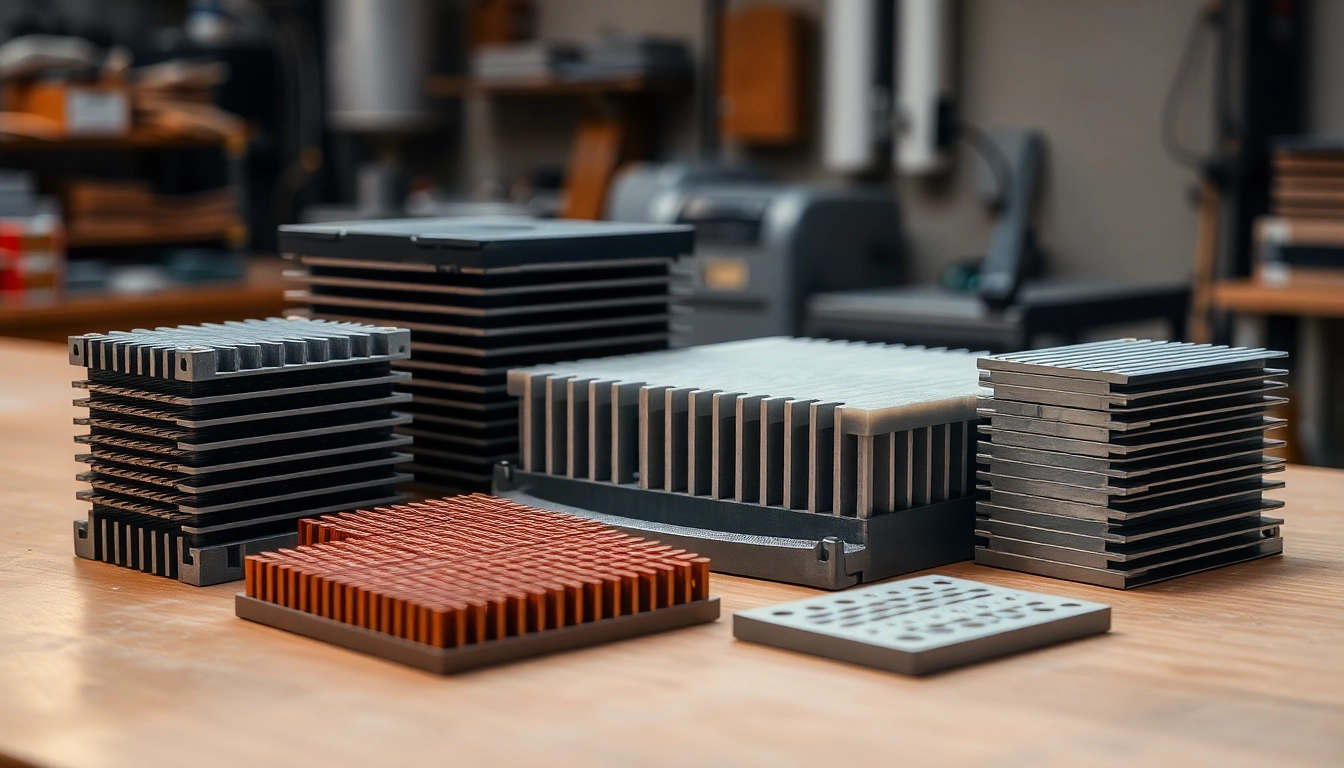Introduction to Thermal Management Materials
In an era where electronic devices continue to shrink in size while increasing in power, the need for effective heat dissipation has become critical. This is where thermal management materials come into play. These materials are pivotal in managing heat within electronic components and systems, ensuring optimal performance, longevity, and safety. Understanding how these materials function and their applications can lead to better design choices in electronics and improved product reliability.
What Are Thermal Management Materials?
Thermal management materials are specifically designed substances used to control and dissipate heat in various applications, particularly in electronics. These materials are crucial in maintaining the operational temperature of electronic components, thus preventing overheating, which can lead to device failure or reduced performance. They come in various forms, including thermal pastes, gap fillers, heat sinks, and phase change materials, each catering to different thermal management needs.
The Importance of Effective Heat Dissipation
Effective heat dissipation is vital for several reasons:
- Device Performance: Excessive heat can adversely affect device performance, leading to slower processing speeds and increased energy consumption.
- Longevity: Overheating can damage sensitive components, resulting in a significantly reduced lifespan of electronic devices.
- Safety: Inadequate heat management can pose safety risks, as high temperatures can lead to fires or explosions, particularly in battery-operated devices.
Thus, the implementation of effective thermal management materials is not only a matter of enhancing performance but also a critical factor in safeguarding devices against thermal-related failures.
Common Applications in Electronics
Thermal management materials find extensive applications across various electronic systems, including:
- Consumer Electronics: Smartphones, laptops, and tablets utilize thermal interface materials to ensure that processors and batteries operate within safe temperature limits.
- Automotive Electronics: Modern vehicles have numerous electronic components, including sensors, control units, and power electronics, all of which need efficient heat management to ensure reliability.
- Telecommunications: Servers and networking equipment, which generate significant heat while in operation, rely heavily on advanced thermal materials to maintain performance and prevent downtime.
- Power Electronics: Devices used in power management systems require high-performance thermal materials to manage the heat produced during operation.
Types of Thermal Management Materials
An array of thermal management materials is available, each serving unique functions based on their properties and application requirements. Below are the most commonly used types:
Thermal Interface Materials (TIM)
Thermal Interface Materials (TIM) are crucial in efficiently transferring heat between two surfaces, typically between a semiconductor device and a heatsink. They fill microscopic air gaps present due to surface imperfections, which would otherwise impede heat transfer. Common TIMs include:
- Thermal Greases: These are viscous materials that offer high thermal conductivity and are easy to apply. They are often used in CPU and GPU applications.
- Thermal Pads: Solid pads that provide good thermal conductivity and are easier to handle than greases. They are commonly used in various electronics.
- Phase Change Materials: These materials change their phase from solid to liquid at specific temperatures, allowing them to absorb and dissipate heat effectively when they melt.
Phase Change Materials (PCM)
Phase Change Materials play a vital role in thermal management by storing and releasing energy when they change phases. When temperatures rise, PCMs absorb excess heat, and when temperatures drop, they release that heat, helping to stabilize temperatures in electronic devices. This characteristic is particularly advantageous in applications requiring temperature regulation, such as:
- LED Lighting: PCMs help maintain optimal operating temperatures, thereby extending the life of LED bulbs.
- Battery Management Systems: They manage temperature fluctuations in battery systems, enhancing performance and safety.
Gap Fillers and Spacers
Gap fillers and spacers are used to bridge the gap between components that need to transfer heat. They are often made from soft materials that conform to the surfaces of the devices they are applied to. Their primary functions include:
- Filling Gaps: They fill spaces where direct contact between components is not possible, ensuring better thermal coupling.
- Vibration Damping: Certain gap fillers also act as dampers, minimizing mechanical vibrations that could lead to component failure.
Choosing the Right Thermal Management Material
Selecting the appropriate thermal management material is critical for optimizing performance in electronic applications. It involves understanding several key factors:
Factors to Consider: Conductivity, Thickness, and Compliance
When choosing thermal management materials, the following factors should be considered:
- Thermal Conductivity: This is a measure of a material’s ability to conduct heat. Higher conductivity materials will dissipate heat more effectively.
- Thickness: The thickness of the material can affect heat transfer. Thicker materials may impede heat flow, whereas thinner materials improve efficiency.
- Compliance: The ability of a material to conform to the surfaces it contacts is vital for effective heat conduction. Materials should be soft enough to fill gaps and irregularities while maintaining structural integrity.
Comparative Analysis of Popular Brands
Several leading brands manufacture thermal management materials, each offering a unique set of products tailored for various applications:
- Henkel Adhesives: Known for its comprehensive range of thermal management solutions, Henkel provides materials designed for high-performance applications.
- DuPont: Offers products such as the Temprion® line, which includes films and adhesives specifically formulated for thermal management.
- Laird Technologies: Specializes in custom thermal interface materials that improve heat transfer in critical applications.
When comparing these products, it’s important to analyze factors such as thermal performance, ease of use, and environmental impact.
Cost-Effectiveness vs. Performance
When selecting thermal management materials, a balance between cost-effectiveness and performance must be found. While high-performance materials may offer superior thermal conductivity, they often come at a higher price point. In contrast, lower-cost options may not provide adequate thermal management, leading to potential device failures.
Conducting a thorough analysis of the specific application requirements, long-term operational costs, and potential risks of overheating can aid in making an informed decision.
Best Practices for Implementation
Successful implementation of thermal management materials requires careful planning and execution. Here are some best practices to ensure optimal performance:
Installation Techniques for Optimal Performance
Proper installation techniques are essential to maximize the effectiveness of thermal management materials. Here are some recommended practices:
- Surface Preparation: Ensure that both surfaces are clean, dry, and devoid of any contaminants before applying materials.
- Uniform Application: For thermal greases, apply a thin, even layer to ensure effective heat transfer without excess material that may hinder performance.
- Proper Pressure Application: Apply consistent pressure to ensure good contact between components and the material used.
Maintenance and Monitoring Methods
Once thermal management materials are installed, ongoing maintenance and monitoring are crucial. Regular checks for degradation, such as cracks or wear in pads or greases, should be performed. Implementing temperature monitoring solutions can also help track performance and alert for any overheating issues early.
Common Mistakes to Avoid
Here are some common mistakes to avoid in thermal management:
- Over-application: Applying too much thermal interface material can lead to poor thermal conductivity and hinder heat dissipation.
- Ignoring Compatibility: Using materials that are not compatible can result in chemical reactions that degrade performance and cause damage.
Future Trends in Thermal Management
As technology progresses, so do the materials and methods used in thermal management. The future looks promising with several key trends emerging:
Advancements in Material Science
The field of material science continues to innovate, with new materials being developed that exhibit superior thermal properties and functionalities. Nanomaterials, for example, are being explored for their potential in enhancing heat dissipation and improving the efficiency of thermal management systems.
Impact of Technology on Thermal Solutions
With the rise of advanced technologies such as artificial intelligence and machine learning, predictive analytics can be integrated into thermal management systems. This allows for real-time adjustments based on varying operational conditions, improving overall efficiency and reliability.
Sustainable Practices in Thermal Management
As environmental concerns become increasingly prominent, there is a growing focus on sustainability in the production and disposal of thermal management materials. Innovations in biodegradable materials and energy-efficient manufacturing processes are becoming a focal point in the industry.



